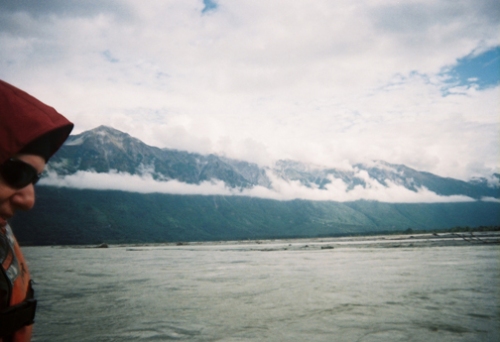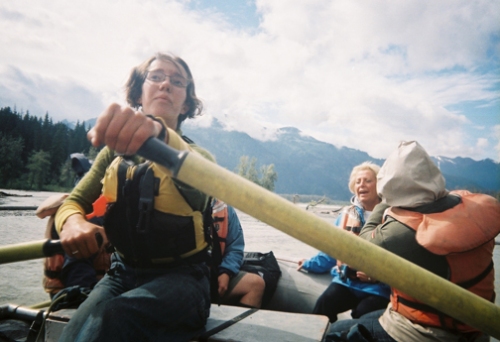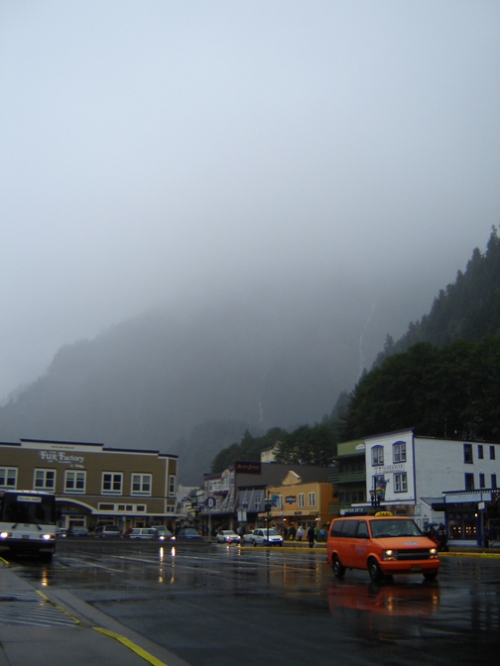(And I would sail 500 miles, and I would sail 500 more . . .)
We left Denali by train, taking a scenic railroad car with a glass top to Fairbanks, our last Alaskan stop. It was just a place to sleep for us: We were on an early morning flight back to Seattle and then Chicago the next day. I had another bout of motion sickness when I got home (even my own bed in Chicago seemed to be rocking underneath me), followed by a cold, and then, back to work and real life.
Before I left, I was already thinking about the cruise to Alaska in part as a scouting mission for a later return with friends, and I took mental notes on that topic throughout the trip.
So here are some lessons learned for those who are planning a trip to Alaska. Some are my own travel preferences but some would apply to anyone.
- Getting around in Alaska requires a lot of advance planning. If you’ve been following this blog at all, you’ve noticed this theme: getting from Point A to B almost anywhere in Alaska can be a challenge. Doing so in the southeast almost always involves travel by sea (or, more expensively, air). Options are limited and usually only available during a few select times during the day, week, and year. If you don’t have a cruise ship company or a traveling companion making the arrangements for you, you’ll want to start your research well in advance and book early.
- Big cruise ships are not for me. In addition to the motion sickness, I found the food to be mostly bad the entertainment mostly unappealing. And my cabin was the only quiet place on the whole enormous ship I could find to read a book in peace. (There was annoying background music—or foreground music—everywhere.)
- Small water vessels are. All of my best moments in Alaska were in rafts, kayaks, and small ferry and whale watching boats, where I got to see spectacular mountain ranges, sea life, and glaciers large and small—sometimes all in the same hour.
- A corollary: scenery from water beat scenery from land during every minute of my 11 day trip across 1,000 Alaskan miles. I’ve planned plenty of trips to beautiful, land-locked mountain ranges in the past (Glacier and Rocky Mountain National Park, most recently) and have been awestruck by the waterless views I was able to reach on my own two feet, along established hiking trails (after a long drive, of course). My Alaskan trip wasn’t like that, and I think Alaska in general isn’t like that—because of the lack of established trails, the terrain, the climate and the ecosystem. When you’re in Denali National Park, chances are good the clouds will not lift sufficiently to reveal Mt. McKinley (Denali). In fact, this is the first vacation I can remember taking that included a national park, where the park wasn’t the highlight of the trip. If you’re not into mountain climbing, you’re better off in a small boat—which doesn’t limit you much. You have 33,000 miles of coastline and an uncountable number of lakes and rivers to choose from.
- Don’t be fooled by guide books—take a tip from your rearview mirror: cultural institutions may be smaller than they appear. If you like small, that’s fine, but from my point of view, outdoors is always better than indoors in Alaska if you can handle the rain.
- Bring waterproof rain gear and wear moisture-wicking layers underneath. And when you’re completely soaked through, and need to go inside for a while . . .
- Avoid the stores on the first two streets that run parallel to the cruise ship docks in Ketchikan and Juneau (probably other places too). Many are owned by the cruise ship companies, and most of their stuff doesn’t come from Alaska. If you must have tchotchkes, you can find an independent artist’s gallery or bookstore or whatnot further into town. Driving into the interior along Seward Highway, you can get books about Alaska for children and adults at the gift shops in the parks and cultural stops (e.g., the SeaLife Center.).
If you’re on a cruise and want some real time outdoors and off a 13-deck ship:
- The excursions arranged by the cruise ship are probably going to fit best into your very tight schedule. If you want to make separate arrangements, see #1.
- Book longer excursions. I signed up for a bunch of 3.5- to 4-hour rafting, kayaking and canoeing excursions, and, inevitably, a large chunk of the time was spent in a bus or van getting to the real destination, with less spectacular scenery from the road. A 3.5-hour kayaking excursion will only get you 2 hours in a kayak. Factor that in.
- It’s not just where you are—it’s who you’re with. On this trip, more specifically, the quality of the guides made all the difference.
Most of the trips I’ve taken over the last decade didn’t involve guides. It’s been more than 20 years since I took an entirely guided vacation (one of those 12-day “It’s Tuesday, it must be Belgium” bus tours of Europe), and I’ve never taken a tour before where I’ve gone on excursions with new guides nearly every day in each new port (ten different guides, not counting the bus drivers or ship captains and spoke a little over a P.A.)
All of the best moments of the trip were with great guides, and it was wonderful to get a chance to meet a variety of people who choose to live in Alaska and find out a little bit about them and their lives there. The best guides conveyed a blend of knowledge and love for the place we were visiting. The less wonderful ones were too busy selling excursions or uninterested in communicating (no doubt tired of tourists), and the scenery couldn’t completely overcome the negative vibe.
Being aware of this principle won’t actually help you plan your cruise tour. There is no way to know who will be guiding you before you sign up for any given outing. Perhaps what it should do is keep you open to a range of possibilities. My predictions about what I would enjoy the most on the trip were largely inaccurate.
An Alaskan return?
So, with 33,000 miles of coastline to choose from, where would I want to go if I returned to Alaska?
If/when I can get the time, money, and traveling companions assembled, I think I would want to fly into Anchorage and then spend the better part of a week kayaking, camping, and hiking around the Prince William Sound. Alaska Sea Kayakers —which ran my kayaking excursion from Whittier—offers preprogrammed and tailored multiday excursions, and I’m sure other outfitters do as well. Ideally, I’d get some more kayaking experience under my belt before going, but it might be possible to arrange a beginner’s trip.
Prince William Sound is certainly not the only great place to undertake such a trip—but it’s the area I got a peek at that I’m most interested in returning to, and one of the easier ones to reach without needing to spend a lot of nausea-inducing time on a big vessel out in the ocean. (The area around Haines is also appealing, but I believe it would be harder to get there directly from home.)
I’m curious about the coastal regions that are farther west along the Alaska Marine Highway than we ever got—the Kodiak Islands and the Aleutian Chain—because they’re even more remote than the places we went to—but I haven’t done any research on them.
If any of my camping and paddling buddies are interested in such a trip, let me know. I’m in no particular hurry. As I said, I’d like to get some more kayaking experience before returning. And there are plenty of beautiful places in the lower 48 that are less expensive, more accessible, and better suited to our current interests, skills, and commitments (such as diaper washing, for instance). As an example, Acadia National Park in Maine seems to offer a great combination of kayaking, camping, and hiking along a beautiful mountainous coastline, without the same expense and logistical difficulties that a trip to Alaska entails.
I’m pretty sure that Alaska will still be there if and when we’re ready—although the glaciers will be smaller. Let’s keep our fingers crossed that we can at least avoid a massive oil spill before we get there.

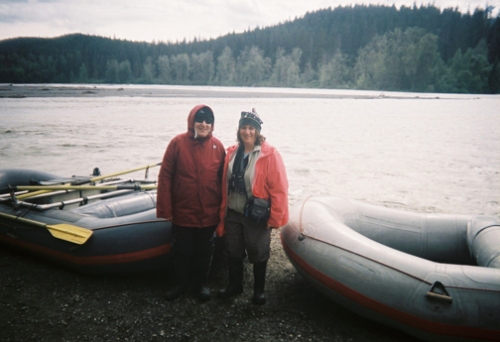
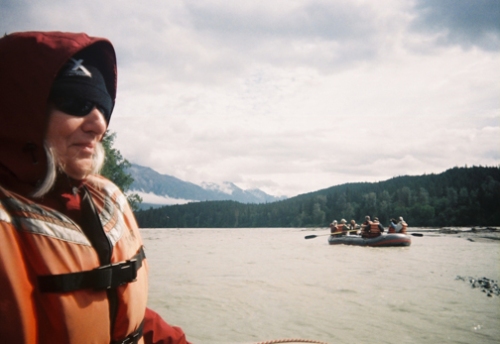
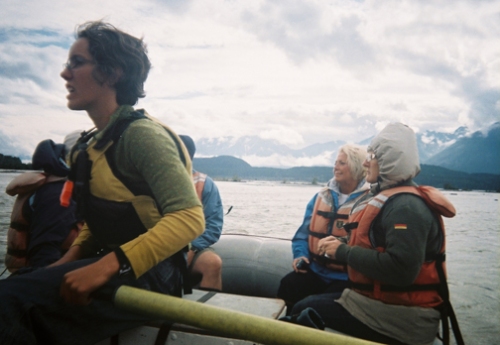 Sylvia checks conditions
Sylvia checks conditions